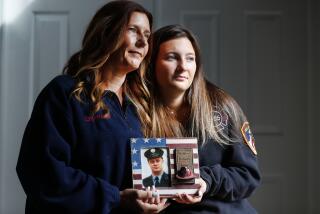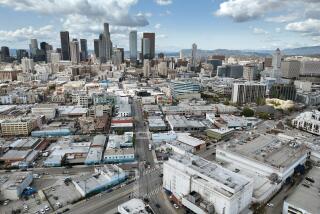Major steps coming for World Trade Center in New York this year
- Share via
More than 26,000 people have worked to rebuild the World Trade Center complex, and many will continue working there for years until the five skyscrapers, transportation hub and retail complex on the site have been completed.
It’s a huge project, spanning 16 acres with an overall cost of about $14.8 billion — up from a 2008 estimate of $11 billion. And it has taken a long time to come to fruition.
Although the site cleanup officially ended in May of 2002, construction on One World Trade Center, the 1,776-foot tall centerpiece of the site, didn’t begin until 2006. Its original design was altered because of security concerns.
Developers say the opening of One World Trade Center, expected later this year, will be a big step toward restoring a part of the city closed since 9/11.
PHOTOS: Spire installed on World Trade Center tower
“It’s a huge step — it’s no longer ground zero, it’s the World Trade Center now,” said Douglas Durst, whose company, the Durst Organization, partnered with the Port Authority of New York and New Jersey to complete the building. “It’s going to be a dramatic change. All of a sudden something that’s been completely closed off is going to be visible and accessible.”
There’s still a lot of work left to do, though. Officials held a ribbon cutting ceremony for 4 World Trade Center in November, but the Port Authority and other tenants probably won’t move in until 2015. The transportation hub and retail section of the site also won’t open until 2015.
The National September 11 Memorial & Museum will open later this year, but developers are still negotiating the costs for buildings such as 3 World Trade Center, stalled until a tenant was found last month.
That means a lot more work for people such as Jesus Rivera. Rivera is a steward for the Laborers International Union of North America Local 79, and has been working on 4 World Trade Center for more than four years. When he’s done on that building, he’ll move to 3 World Trade Center. Like many of the building’s workers, he left his signature on a steel beam in the building, alongside President Obama’s.
The job pays well, but it makes for a long day. Rivera leaves his house in Monroe, N.Y., at 4 a.m., takes a bus and arrives in the city two hours later. Recently, he’s been working seven days a week to complete the project.
Like many of the workers on the site, he was at ground zero for the cleanup after the attacks, on a bucket brigade clearing rubble. His wife is a corrections officer and was cleaning the site too. Rivera lost two friends in the attacks, and he says it’s powerful to work at the site and talk to victims’ families.
It can be scary too: In 2009, a jet plane flew terrifyingly close to the building. Rivera and other workers started running as it approached, until the word got out: it was Air Force One on an ill-advised flyover of New York.
In a project so big, there are very real dangers. As the wind and rain whipped One World Trade Center during Superstorm Sandy, Phil English couldn’t find one of his men. When the power ran out, he ran down 85 flights of stairs with only a helmet light.
Searchers finally found the man trapped in the basement, where waves flooding in from the river were hitting the door so hard that he couldn’t get out. They wrenched the door open, but by the time they rescued him, it was too late to go home. All transit had stopped, and roads were impassable. English and a few other workers slept on the floor of a building nearby for two nights, their boots and clothes ruined by mud and water.
The challenges faced by English are chronicled in a Los Angeles Times profile. He began working on the site after his wife died of cancer, and over the years rebuilding the tower helped him rebuild his life.
Like Rivera’s, his days are long too: During the last few months, English has awakened at midnight to catch a 1 am bus that takes him from his home in the Bronx to the subway. Then he takes the subway’s 6 Line for 35 stops, to work. From about 3 a.m. until 7 a.m., he and a crew go up and down the freight elevator, emptying garbage and debris from each floor.
He often works until 6:30 p.m. and then goes home and cooks dinner, does laundry and spends time with his kids, now ages 22, 19 and 14.
But the union laborers are well-compensated, which is why so many of the workers say the job is the best one they’ve ever had. For English and Rivera’s union, that means pay of $37 an hour, with overtime pay for any time worked over eight hours a day, and time and a half on Saturdays, double time on Sundays. It has ended up being a lot of overtime — English went two years without a vacation, working nearly every day.
“Because of this job, I was able to provide my kids with the best of everything,” English said. “I bought my daughter a Mercedes Benz. I paid for her college. I bought my son a car.”
The cost of One World Trade Center is now $3.9 billion, up $700 million from the last estimate, making it the most expensive building in the world. Developers also say it is the safest building in the world: it has a firefighters’ elevator, which is waterproof.
ALSO:
‘Polar vortex’ could send wind chill to 65 below zero in Midwest
Former First Lady Barbara Bush released from Houston hospital
Cronut-crazed New Yorkers brave frigid temperatures for pastry
Twitter: @AlanaSemuels
More to Read
Sign up for Essential California
The most important California stories and recommendations in your inbox every morning.
You may occasionally receive promotional content from the Los Angeles Times.











